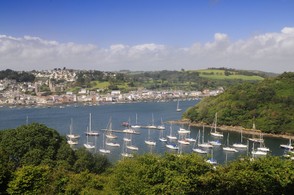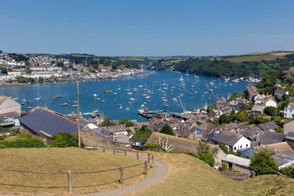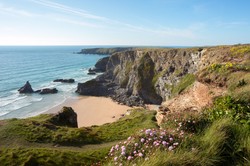Cornwall is a land of cliffs, so one day that holiday we walked along the cliff top path from Fowey to Polperro. The walk contrasts the white flecked wilderness of the sea below with the wide, fertile expanses of Cornish farmland rolling away into the distance on the other side.The path went eastwards, a narrow strip between the fields and the wildly vegetated cliff edge, with its rich abundance of flora: heather, gorse, bracken and at places the intrusive Hottentot fig, Carpobrutus edulis, a South African plant introduced to Britain that went wild and thrived on our south west coastal cliffs. It has redeeming virtues, being both pretty and having edible fruit. However, those who dislike non-native species are now trying to control this pretty immigrant. I doubt that they will eradicate it entirely, as it has a place on our shores, and to be truthful, I want it to stay.
The path undulated up the cliffs, sometimes steeply ascending, all the time on firm turf that was springy to the feet, and marked off from the cliff edge by a fence to protect the unwary from a nasty fate. Once we negotiated our way gingerly through a herd of cattle. We were a bit nervous, but we were later to find out from a farmer that the bulls to be afraid of are dairy bulls, and these were mainly bullocks kept for beef, and we suffered no problems.
At one time we descended along a rocky path to one of the small coves that characterize the Cornish coast. This was safe, but not very easy descent , but it gave access to the beach where we could walk around for a while, before ascending again and continuing our perambulations.
The great joy of this walk was the peace and quiet. We could sit on a patch of turf and eat our lunch, all the time conscious of the deep quietness of nature, with only rare sounds emanating from the farm animals on one side, and the rumbling roar of the sea, loud when it is near you, but on this day high on the cliffs diminished to a low, but incessant susurration. to which the cries of the gulls made the occasional accompaniment. I was reminded of the Celtic saints who considered the sounds of animals, the singing of birds, the croaking of frogs and the lowing of cattle, as worthy equals of the psalms sung by monks, however discordant they may seem to our human ears.These Celtic saints belong in the history of this Celtic county, and they remind us that human standards of beauty are not the ultimate yardsticks against which beauty is to be measured.
To appreciate the town you must be for some time out of it, and while I enjoyed the cliff top walk arrival in the village of Polperro was welcome. It is a town that was once a fishing village, but is now focused on tourism, and it is a very pleasant site to stay or conclude a walk. We both felt like a spell in a tea shop, so we indulged our appetites with tea and cake, fruit cake for me, carrot cake for Maureen, and being British, tea for both. Tired now, we took the bus back to Fowey, where we retrieved the car and returned to our cottage.








 Women of the Gospelson 10/11/2025
Women of the Gospelson 10/11/2025
 Religious Gardenson 08/25/2025
Religious Gardenson 08/25/2025
 Doctor of the Church: John Henry Newmanon 08/03/2025
Doctor of the Church: John Henry Newmanon 08/03/2025
 Restoring the Palm Houseon 07/16/2025
Restoring the Palm Houseon 07/16/2025



Comments
Many Cornish place names are anglicized into something that sounds English. Roseland, which means, as you say, Red Lake, is one of them.
Your comment Feb. 4, 2022, to my previous, same-day question gives as an example of lost Cornish derivations Roseland, not from the English phrase "land of rose-specied flowers" but as from the Cornish phrase ros lyn for "red lake."
Online sources nowhere list the aforementioned Cornish phrase or its proper English counterpart.
Might that loss of etymological associations be common or uncommon among native Cornwall-ers?
Or would native Cornwall-ers still know that etymology?
I have never visited Lanyon Quoit. Cornwall is 360 miles by road from me, so it is not place where I would go for an occasional short visit. I have visited on several occasions, but not as much as I would like, so there are areas of Cornwall that I have not seen.
I'm in the process of re-reading all your wizzleys for the third time now (I just finished re-reading Veronica's for the third time ;-D). This wizzley caught my attention even though I intend to start from the very first wizzley and work my way to the recentest.
The Bing image for Pi Day was of the Lanyon Quoit burial chamber in Cornwall. Would you and your wife happen to have gone there on any of your Cornish peregrinations?
I have not heard of Shakerag as a Cornish tradition, and I have not found a place called Shakerag, despite my looking through a place name reference book. Cornish place names, however, are Celtic rather than Anglo-Saxon, and some of them are quite peculiar, being basically Celtic names modified by the presence of English. Look at "St Antony in Roseland", which has nothing to do with roses. St Antony is parish, but Roseland is a derivation of Ros Lyn the red lake. I do know that Cornish miners did not go home for lunch, but took Cornish pasties with them, so I suspect that the shakerag tradition exists to explain a Cornish word that has survived. It may therefore be a word in Cornish that has been transmuted by the effect of English.
Maureen and I heard no Cornish spoken, though there have been attempts to revive the language. The language is considered to be a relation of Welsh, though the two languages are not mutually comprehensible.
frankbeswick, Thank you for the guided tour that so thoughtfully includes scents, sights, and sounds.
Do you know of any place in Cornwall being called Shakerag? It's the name of a main street in the small town of Mineral Point, settled by Cornish farmers and miners whose wives would stand outside the door and shake cloth to indicate that lunch or dinner was ready. Is it possible that, if true, it's a tradition brought across the pond from Cornwall?
Did you and your wife hear Cornish being spoken? It's my understanding that the death of the last life-long native speaker has been followed by attempts to re-establish the language.
Your response greatly pleases me, as my aim is to take people with me on walks that they could not normally do.
Thank you for taking me on this lovely walk in Cornwall. When I was young my aunt and uncle had a place in Devon which we visited a few times, and made a foray or two into Cornwall. I'd love to go back!
Thank you, the great joy of being a writer is to share what I cherish with others.
Though I will probably not be privileged to see it in this lifetime, you have really aroused my interest in Cornwall with this piece. What a wordsmith you are. Frank! Enjoyable fro beginning to end, but I particularly liked your description of the river Fowley near the beginning.